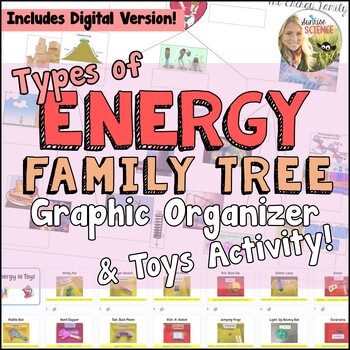Energy Types and Transformations Graphic Organizers and Toys Activity
- Zip
What educators are saying
Also included in
- This is a bundle of all of my resources for teaching physical science at the middle school level! These resources include a mix of Cornell Doodle Notes, labs, demonstrations, inquiry activities, self-paced digital 5E lessons, manipulatives, projects, pixel art review activities, and assessments. IPrice $297.00Original Price $384.06Save $87.06
- This is a bundle of all of my resources for teaching physical science at the 8th grade level WITHOUT the Cornell Doodle Notes included. I put together this bundle upon request from customers who had already purchased my Growing Bundle of Physical Science Cornell Doodle Notes or my Entire Store BundPrice $187.00Original Price $246.28Save $59.28
Description
This Energy Types and Transformations Graphic Organizers and Toys Activity lesson helps students to sort out the different “flavors” of energy by organizing them into a “family tree” with “Pa Energy” and “Ma Everything” at the top (Albert Einstein once said, “Everything is energy and that’s all there is to it!”), and below them their “children” Kinetic and Potential, and their “grandchildren” -- thermal, sound, electrical, and radiant are kinetic energies…gravitational, nuclear, chemical, and elastic are potential energies.
This graphic organizer is two-sided...one side has fill-in notes that follow the Powerpoint, and the other shows just the pictures from the Powerpoint...this side is good to use as a formative assessment. Show the Powerpoint to walk your students through completing their "Energy Family Tree". The Powerpoint includes graphics and a few video clips to help students to differentiate between each type of energy. At the end, introduce the concept of the Law of Conservation of Energy and energy transformations by discussing what a Rube Goldberg machine is and watching a video clip of a neat Rube Goldberg machine in action.
This is a perfect segue into the Energy in Toys Activity. A trip to the Dollar Store is all you need to gather various fun, simple toys for Energy in Toys activity during which the students will practice thinking about energy transformations! Slinkies, wind-up toys, hand-clappers, zip-fliers, light-up microphones, and/or whatever toys you have on hand will work!
Students LOVE getting to play with toys for 20 minutes while they consider the types of energies being employed by each.
An quick at-home task can be assigned for homework.
This resource includes:
- Teacher Notes
- Two Graphic Organizers (one with just text and one with just pictures) - included as both PDF and digital Google Slides versions
- Energy Family Tree Presentation that goes with the graphic organizers (included as both editable PPT and Google Slides versions)
- Energy in Toys Student Worksheet
- Toy Station Labels
- Energy in Toys "Answer Key" Presentation (included as both editable PPT and Google Slides versions)
I find that this lesson really sticks with students as it employs all learning styles!
You may also be interested in my Energy Forms and Transformations Cornell Doodle Notes!
Thanks for looking!
Sunrise Science







